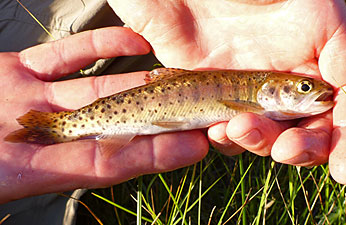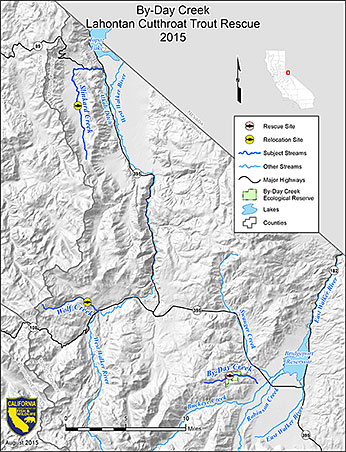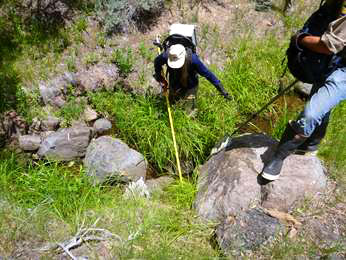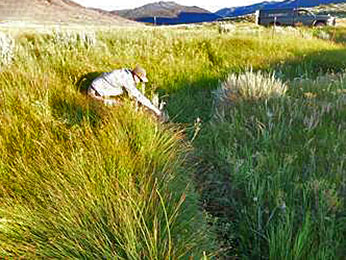(Mono County)
Species Status/Location
 By-Day Lahontan Cutthroat Trout
By-Day Lahontan Cutthroat Trout
 (click/tap to enlarge)
(click/tap to enlarge)
By-Day Creek is a small tributary stream in the headwaters of the Walker River basin, home to a remnant population of Walker Basin Lahontan cutthroat trout (Oncorhynchus clarki henshawi). Lahontan cutthroat trout (LCT) are listed as threatened under the Federal Endangered Species Act (ESA). LCT were one of the original fishes ESA listed; first classified as endangered in 1970, and then reclassified as threatened in 1975 (USFWS 1995). Reasons for decline, which are listed in the Recovery Plan (PDF) for Lahontan Cutthroat Trout include: alteration and reduction of stream discharge, stream channel alteration, poor water quality, reduction of lake levels and introduction of non-native fish species. Prior to the mid -1800’s, only native fish species inhabited waters within the Lahontan Basin.
The By-Day Creek Ecological Reserve is a 460- acre CDFW owned property that contains a portion of By-Day Creek. The property was acquired for the preservation of critical aquatic and riparian LCT habitat. The reserve is surrounded entirely by public lands of the Humboldt-Toiyabe National Forest (HTNF). Joint LCT management and recovery efforts have resulted in the completion of stream restoration projects such as channel stabilization and enhancement of fish cover.
Despite these efforts, the Walker Basin LCT population has continued to decline. Nearly all of California’s wild LCT populations are found in small stream habitats, and are particularly vulnerable to climate change.
Rescue Methods
Electrofishing gear (Figure 1) was used along with dip-nets to remove LCT from the designated reaches of By-Day creek. Captured fish were placed immediately into cold, fresh water, measured, fin-clipped for genetic analysis, adipose-fin clipped for identification and placed into oxygenated tanks filled water from the relocation site. Salt (NaCl) and ice were added to the tank water to reduce fish stress. Transportation required 1-2 hours. The rescued LCT were placed into two established refuge LCT populations at Slinkard Creek and Wolf Creek (established from By-Day LCT in the 1980s and 1990s, respectively). Fish were carefully released in small batches to prevent overcrowding of existing fish (Figure 2).
 Figure 1. Backpack electrofishing and dip nets were used to capture fish from By-Day Creek, 2015.
Figure 1. Backpack electrofishing and dip nets were used to capture fish from By-Day Creek, 2015.
 Figure 2. CDFW staff carefully released LCT into the pre-established refuge site in Slinkard Creek, July, 2015.
Figure 2. CDFW staff carefully released LCT into the pre-established refuge site in Slinkard Creek, July, 2015.
Results
CDFW relocated 49 Lahontan cutthroat trout from By Day Creek on July 23, 2015 and an additional 37 were rescued on August 10, 2015 (Table 1). The majority of rescued fish were adults, with a few juveniles. Only one LCT did not survive the trip.
Table 1- Rescue date, number of LCT transported, release locations, release date, number of LCT released, 2015.
| Rescue Date |
# Transported |
Release Location |
Release Date |
Released # |
| 7/23/15 |
25 |
Wolf Creek |
7/23/15 |
25 |
| 7/23/15 |
25 |
Slinkard Creek |
7/23/15 |
24 |
| 8/10/15 |
37 |
Wolf Creek |
8/10/15 |
37 |
Monitoring
by-day creek habitat, streamflow, and temperature will continue to be monitored during the summer of 2015. it is likely that habitat conditions will deteriorate further, to the point that additional lct may be needing rescue from the drying stream. rescue options being considered include further translocations and possibly rescue to captivity at a hatchery isolation facility if lct population declines to critically low numbers.
Partners
fisheries staff stationed at the Humboldt-Toiyabe national forest, and U.S. fish and wildlife service were informed about monitoring activities, results, and the potential for rescue/translocations. they were alerted to the decision to move LCT to the other walker drainage streams.
References
USFWS, 1995. Lahontan cutthroat trout, Oncorhynchus clarki henshawi, Recovery plan. Portland, OR.